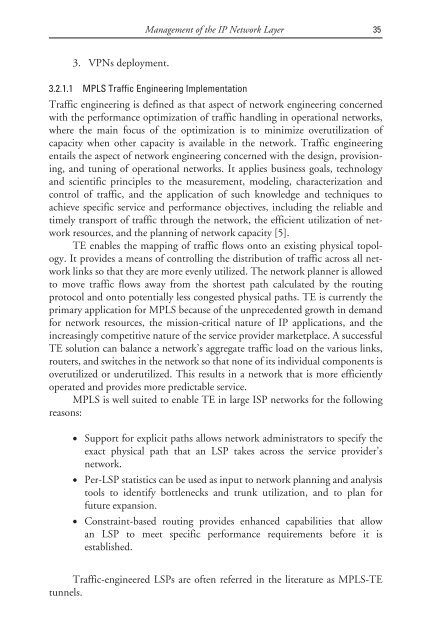deploying and managing ip over wdm networks - Index of
deploying and managing ip over wdm networks - Index of
deploying and managing ip over wdm networks - Index of
You also want an ePaper? Increase the reach of your titles
YUMPU automatically turns print PDFs into web optimized ePapers that Google loves.
3. VPNs deployment.<br />
Management <strong>of</strong> the IP Network Layer 35<br />
3.2.1.1 MPLS Traffic Engineering Implementation<br />
Traffic engineering is defined as that aspect <strong>of</strong> network engineering concerned<br />
with the performance optimization <strong>of</strong> traffic h<strong>and</strong>ling in operational <strong>networks</strong>,<br />
where the main focus <strong>of</strong> the optimization is to minimize <strong>over</strong>utilization <strong>of</strong><br />
capacity when other capacity is available in the network. Traffic engineering<br />
entails the aspect <strong>of</strong> network engineering concerned with the design, provisioning,<br />
<strong>and</strong> tuning <strong>of</strong> operational <strong>networks</strong>. It applies business goals, technology<br />
<strong>and</strong> scientific princ<strong>ip</strong>les to the measurement, modeling, characterization <strong>and</strong><br />
control <strong>of</strong> traffic, <strong>and</strong> the application <strong>of</strong> such knowledge <strong>and</strong> techniques to<br />
achieve specific service <strong>and</strong> performance objectives, including the reliable <strong>and</strong><br />
timely transport <strong>of</strong> traffic through the network, the efficient utilization <strong>of</strong> network<br />
resources, <strong>and</strong> the planning <strong>of</strong> network capacity [5].<br />
TE enables the mapping <strong>of</strong> traffic flows onto an existing physical topology.<br />
It provides a means <strong>of</strong> controlling the distribution <strong>of</strong> traffic across all network<br />
links so that they are more evenly utilized. The network planner is allowed<br />
to move traffic flows away from the shortest path calculated by the routing<br />
protocol <strong>and</strong> onto potentially less congested physical paths. TE is currently the<br />
primary application for MPLS because <strong>of</strong> the unprecedented growth in dem<strong>and</strong><br />
for network resources, the mission-critical nature <strong>of</strong> IP applications, <strong>and</strong> the<br />
increasingly competitive nature <strong>of</strong> the service provider marketplace. A successful<br />
TE solution can balance a network’s aggregate traffic load on the various links,<br />
routers, <strong>and</strong> switches in the network so that none <strong>of</strong> its individual components is<br />
<strong>over</strong>utilized or underutilized. This results in a network that is more efficiently<br />
operated <strong>and</strong> provides more predictable service.<br />
MPLS is well suited to enable TE in large ISP <strong>networks</strong> for the following<br />
reasons:<br />
• Support for explicit paths allows network administrators to specify the<br />
exact physical path that an LSP takes across the service provider’s<br />
network.<br />
• Per-LSP statistics can be used as input to network planning <strong>and</strong> analysis<br />
tools to identify bottlenecks <strong>and</strong> trunk utilization, <strong>and</strong> to plan for<br />
future expansion.<br />
• Constraint-based routing provides enhanced capabilities that allow<br />
an LSP to meet specific performance requirements before it is<br />
established.<br />
Traffic-engineered LSPs are <strong>of</strong>ten referred in the literature as MPLS-TE<br />
tunnels.


